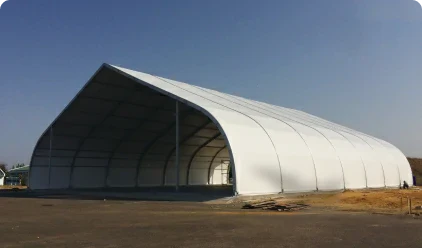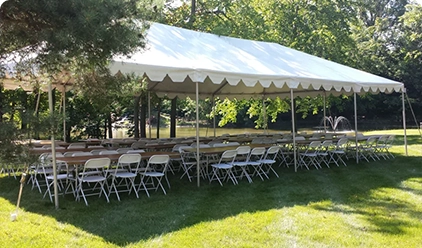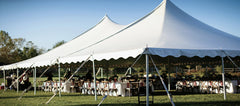Discover the Best 7 Ways to Anchor Tents in Sand Safely and Simply

It's a great idea to take your tent to the beach and anchor it there. It protects you from UV rays, keeps you cool in hot weather, and provides a safe place to store your belongings, among other things.
But when you anchor a tent in sand, you often run into a big problem: the loose sand makes it difficult to anchor the tent, especially when the sea breeze is strong. This makes it easier for your tent to blow over.
To ensure your tent is solid and unshakable on the beach, here are 7 effective methods of staking a tent in the sand that can help you deal with the instability and wind challenges of the beach, ensuring that your beach activities are protected from the wind and sand.
🎈You May Also Read: 4 Best Beach Canopies to Enjoy Fun in 2025
7 Best Ways to Anchor Canopy Tents on the Beach
Next, we'll detail seven ways to keep your party tent from blowing away on the beach. These methods of staking a tent in the sand can help you keep your tent nice and stable, so you can relax and enjoy stress-free time on the beach.
#1 Use Beach Tent Stakes and Tent Pegs in Sand
Using beach tent stakes and tent pegs in sand is important to ensure a safe, stable, and enjoyable time outdoors. Using tent stakes and tent pegs in sand is worthwhile for several reasons:
- Anchor the Tent
Beach tent stakes and tent pegs help keep the tent stable by securing the drawstrings or bottom edges to the sand.
- Safety
Using tent pegs and stakes can help your tent stand up to the wind and reduce the risk of it being lifted or collapsed. Tightening the tent pegs keeps the tent stable and prevents rain from leaking in.
- Portability
Most tent stakes and tent pegs are lightweight and portable, which makes them great for travelers to pack for easy tent setup.
Using a heavy-duty stake is more secure than a traditional stake when you anchor a tent in the sand. Heavy-duty stakes are made from high-strength steel and are tough and durable.
They're designed to give you a better grip and more stability, so the tent is less likely to be blown around by the wind.
Heavy-duty pegs are longer and thicker than regular pegs, so they're less likely to slide in soft sand. They can go deep into the sand to give the tent a solid fix and help it stay put, and they can take a lot of pressure to keep them from bending or breaking, even when the wind is strong.
This helps keep the tent stable. They work well on sandy beaches, and they're great on other unstable surfaces, too, like dirt or grass.

How to Stake Tent in Sand
Now that you know what tent stakes do, let's look at how to stake a tent in the sand. There are just two simple steps:
Step 1: You need to use a mallet or hammer to drive the stakes into the sand at a 45° angle, with the stakes pointing away from the tent.
Step 2: Tie ropes to the stakes to form a "V" with the tent, ensuring they're evenly distributed for balanced tension.
This will make the tent more stable and help it stand up to the elements. In strong winds, the ropes will pull the stakes in opposite directions, creating a stationary stake.
If you're not sure how to do it, check out Sheltent's frame tent erection video. It might help.
How to Tie Down Tent on the Beach
To make the tent more stable on the beach, at Sheltent, we offer ratchets fixed around the tent, providing a strong pulling force to anchor your tent in sand.
#1 Use Ratchets
Here's how to use ratchets to tie down a tent on the beach.
• Get the Ratchets Ready
Get ratchets and drawstrings. Ratchets are usually made of metal or plastic and are designed to provide a steady pull.
• Tie the Drawstrings
Pass the tent drawstring through the ratchet clamp. Tie one end of the drawstring to a tent corner. Attach the other end of the ratchet to a beach fixture.
• Tie the Tent Securely
Turn the handle to tighten the straps. The ratchets tighten the straps. Keep ratcheting until the tent is tight against the beach. Don't over-tighten. It may damage the tent or fixtures.
#2 Use Tent Legs
Tents usually come with tent legs to hold them in place. How to use tent legs to anchor your tent on the beach?
• Find a flat, dry spot on the beach to set up your tent. Make sure the area is away from waves and wet spots.
• Install the tent legs. Put each tent leg into the sand to make sure they're secure. The sand on the beach is soft, so you might need to press hard or use a tool to insert the side legs.
• Tent legs might be secured differently depending on the type of tent. For example, a pole tent will be secured by burying the side legs while a frame tent can be staked by installing a base plate on the side legs.
• Attach the tent to the legs. Some tents have special attachment points for the bottom edges or drawstrings. Make sure the legs are attached to the tent.
• Tighten the tent's drawstrings after connecting it to the side poles. Tighten the drawstrings so the tent stays flat and stable. This will prevent it from deforming in the wind or on uneven ground.
• Check the tent's stability. If it's not stable, adjust the tent legs and drawstrings. Ensure the tent remains stable throughout erection.
#3 Use Sand Anchor
Sand anchors are a great way to secure a tent on the beach. The spiral design sand anchors are designed for loose sand and keep tents stable in windy weather.
Before you install the sand anchor, dig a hole near the tent that's the same length as the anchor. This pit will help you insert the sand anchor better and bury it deeper.
Then rotate and push the sand anchor in so that it is completely buried in the sand. Secure the tent to the hook or loop used for the drawstring of the sand anchor and pull the tent drawstring tight.
Finally, check that the sand anchor is secure and the tent is stable, to prevent it from moving and make adjustments if necessary.

#4 Sandbags
Sandbags are a great, simple way to anchor your tent in the sand. Sandbags are made of tough fabric and filled with sand. You can buy sandbags or even make your own with sand from the beach, which is inexpensive and eco-friendly.
Place the sandbags above the tent drawstrings for better anchorage. Each sandbag weighs at least 20 pounds. Adjust the weight of the sandbags to match the wind and tent size. If the tent is still unstable, add sandbags or use heavier ones.
Press the sandbags into the sand with your feet to keep them from moving in the wind. Check regularly that the sandbags are fixed properly because the wind and sand on the beach can change.
#5 Rock Stacking
If you're looking for a practical way to anchor your tent in the sand, then rock stacking is a great option. This method uses the weight and stability of the rocks to secure the tent.
Find some large, flat rocks that are heavy enough to withstand the wind. Put your pull string on the foundation stone and push the tent stakes into the ground behind it.
Check that the tent is stable and that the stones are firmly pressed into the sand and won't move easily. Add more stones if needed.
#6 Use Buckets of Water
You can also use buckets of water to anchor your tent, especially if you're at the beach. They're simple to use, effective, and eco-friendly.
All you need is a couple of sturdy buckets and some water. The weight of the buckets will keep the tent in place and stop it from blowing in the wind.
Put the water-filled buckets in each corner of the tent and at the tie-down points. Ensure that the buckets are properly secured to prevent them from falling over and getting the tent wet.
#7 Use Wood Anchor
Wooden anchors are a great solution for beach winds. Use long, sturdy blocks or stakes that can be inserted into the sand. Put the anchor in the sand as deep as you can to make it more stable.
You can use a hammer or other tool to drive the wooden anchor into the sand. Tie the tent to the anchor with the drawstring or tie-down straps. Check that the anchor is firmly in the sand and the tent is stable.
Staking a Canopy in the Sand
What happens if the top of the tent is not compressed? If the tent is not secured, sand can get inside the tent and the tent can be blown away by the wind... To ensure your safety, here are some important tips for staking a canopy tent in the sand with heavy weights.
• Before setting up your canopy tent, check the weather conditions. If there is a chance of high winds, you may need to add some weight or take extra measures to secure the tent.
• Make sure the canopy weight is enough and evenly distributed. Don't put too much weight on one side or the tent will become unstable.
For example, if you're setting up a tent on the beach, a 10x10 canopy is recommended to have a fixed weight of 30-40 lbs per leg in non-windy conditions and 75-100 lbs per leg in windy conditions.
• Use reliable fasteners. Be sure to use sturdy straps or ropes to secure the weight of the tent to the legs or frame.
• It's a good idea to check the counterweights and fasteners periodically to make sure they are secure. Over time, wind and other elements can cause wear and tear, so it's important to make adjustments when needed.
What If You Don't Anchor Your Tent
If you don't secure the tent, you might run into some issues, particularly in windy or unstable weather. Just to give you a heads-up, here are a few examples of problems that can occur:
- Insecurity
If a tent is not secured properly, it can be dangerous, especially in strong winds or bad weather. It's unsafe for campers and others on the sand.
- Tent Shifting
If you don't anchor your tent, it may move in the wrong direction due to wind or other outside factors.
- Tent Tipping
If you experience high winds or a sudden change in weather, the tent may tip over. This can damage the tent itself and its contents, or even tear the tent.
- Water in the Tent
If the edges of the tent are not properly secured, rainwater can seep into the tent when it rains, making it wet and uncomfortable.
To ensure that your tent is safe and secure in any situation, you need to make sure that it is properly secured.
At Sheltent, our tent kits include stakes & ratchets or a tent ballasting system to anchor your tent, enabling you to carry out your tenting activities in the sand or anywhere without any problems.
Extend Reading: How to Keep Canopy Tent in Sand from Blowing Away
Here are some additional reading points to help you keep your tent from blowing away at the beach.
- Make Sure the Sand Surface Is Flat
The first thing you need to do is find the right spot to pitch your tent. Soft sand makes it tough to keep a tent from moving around, so it's essential to have a surface that's as flat and horizontal as possible.
A level surface does a better job of securing your tent in the sand and makes it more comfortable to pitch it, without worrying about tripping over small rocks.
- Pick the Right Tent
Choose a tent designed for sandy terrain or a tent with a reinforced structure and anchoring system suitable for various terrains.
For example, Sheltent's frame tents can be ballasted to suit any terrain: sand, beach, concrete asphalt floors, etc.
- Use the Right Fixings
Use heavy-duty stakes, sand anchors, sandbags, or other anchoring systems to stake the tent in the sand. Make sure the canopy weight is enough and evenly distributed.
Don't put too much weight on one side or the tent will become unstable. Ensure each tent leg weighs at least 40 pounds, and up to 50 pounds or more in rain or windy weather, to keep it stable.
- Make Sure the Drawstrings are Distributed Evenly
It's important to make sure you distribute the weights evenly at each corner of the tent and at the drawstring attachment points to make the tent more stable overall.
Just a heads-up: Try not to over-tension. If you over-tension the tent, you might damage the fabric or loosen the fixings.
- Inspection and Adjustment
Keep an eye on how the tent is fixed, especially when the weather changes or when there's a wind shift. Make sure you adjust the fixings as needed.
Conclusion
If you don't anchor the canopy on the beach sturdily, it can impact your camping safety and experience. We hope these seven ways to anchor your tent in the sand and their step-by-step instructions above will help you secure your tent safely and easily and have a great time. Check out the tents for sale at Sheltent, which come with a variety of mounting options.












































